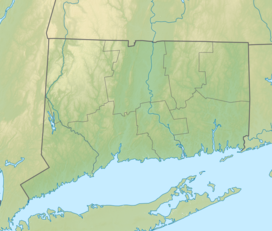| Minnie Island State Park | |
|---|---|
  | |
| Location | Montville and Salem, Connecticut, United States |
| Coordinates | 41°30′20″N 72°13′18″W / 41.50556°N 72.22167°W / 41.50556; -72.22167 |
| Area | 1 acre (0.40 ha) |
| Elevation | 394 ft (120 m) |
| Established | 1925 |
| Administered by | Connecticut Department of Energy and Environmental Protection |
| Designation | Connecticut state park |
| Website | Official website |
Minnie Island State Park is a public recreation area occupying a tiny island at the southern end of 529-acre (214 ha) Gardner Lake that is split by the townline between Salem and Montville, Connecticut. It is accessible only via boat and offers opportunities for picnicking and fishing as well as general exploration in a largely deserted setting. The 0.88-acre (0.36 ha) island is the state's smallest state park.
History
In the 19th century, the island was owned by a popular music teacher, the founder of Salem's Music Vale Seminary, Oramel Whittlesey (1801-1876). Whittlesey named the island for a niece nicknamed Minnie. In the 1920s, an attempt by squatters to take possession led to the discovery that although the island was claimed by both Salem and Montville, it was not on the tax rolls of either town. In solving the dilemma, the state assembly rejected the squatters' proposed legislation, instead passing a law in 1925 that took possession of the island for the state and turned its management over to the state park's commission.
Features
Writers working for the WPA in the 1930s described Minnie Island as "a pine-grown knoll rising from the lake's depths." It has a steep shoreline with gray outcropped ledges that offers few opportunities for docking. It rises approximately sixteen feet from the surface of Gardner Lake which lies at an elevation of 381 feet (116 m). Its northern shore drops off into the deepest portion of Gardner Lake, some 36 feet (11 m). The island is thickly forested with mountain laurel undergrowth amidst large red oaks. A clearing at the summit may be littered with the detritus of previous visitors. There are no facilities of any kind and no signage.
References
- ^ "Minnie Island". Geographic Names Information System. United States Geological Survey, United States Department of the Interior.
- ^ "Other State Parks and Forests". Connecticut Department of Energy and Environmental Protection. Retrieved July 29, 2024.
- ^ "Gardner Lake" (PDF). Connecticut Department of Energy and Environmental Protection. Retrieved October 25, 2017.
- ^ David K. Leff (December 2013). "Minnie Island" (PDF). Connecticut Woodlands. p. 12. Retrieved July 21, 2016.
- Joseph Leary (2004). A Shared Landscape: A Guide & History of Connecticut's State Parks & Forests. Hartford, Conn.: Friends of the Connecticut State Parks, Inc. pp. 111–112. ISBN 0974662909.
- Cindy Lee Corriveau (2006). Salem. Images of America. Arcadia Publishing. p. 71. ISBN 978-0-7385-3945-4.
- "An act providing for the transfer of Minnie Island to the state". Public Acts Passed by the General Assembly. 1925. p. 7007. Retrieved July 21, 2016.
- Workers of the Federal Writers' Project (1938). Connecticut: A Guide to Its Roads, Lore, and People. The American Guide Series. Cambridge, Massachusetts: The Riverside Press. p. 359. Retrieved July 21, 2016.
- "Gardner Lake". Geographic Names Information System. United States Geological Survey, United States Department of the Interior.
External links
- Other State Parks and Forests Connecticut Department of Energy and Environmental Protection